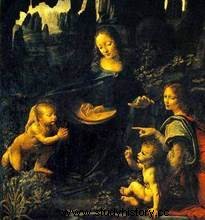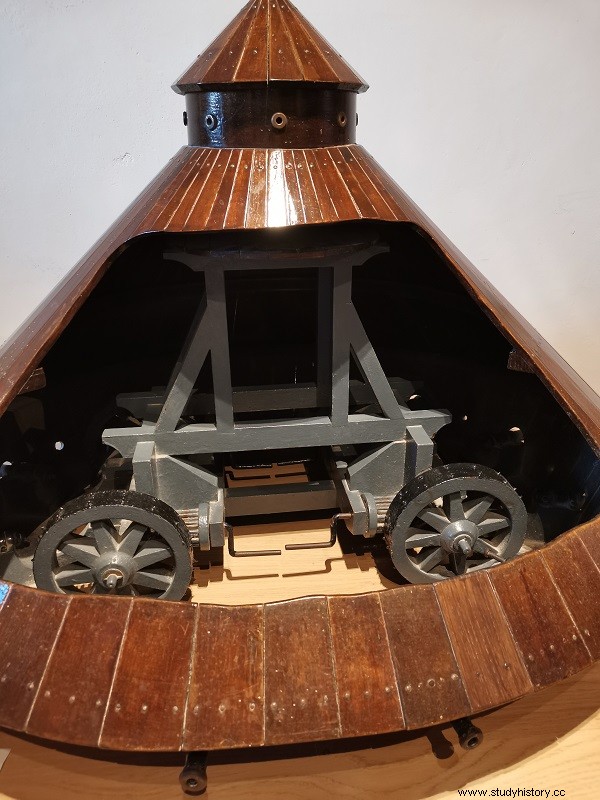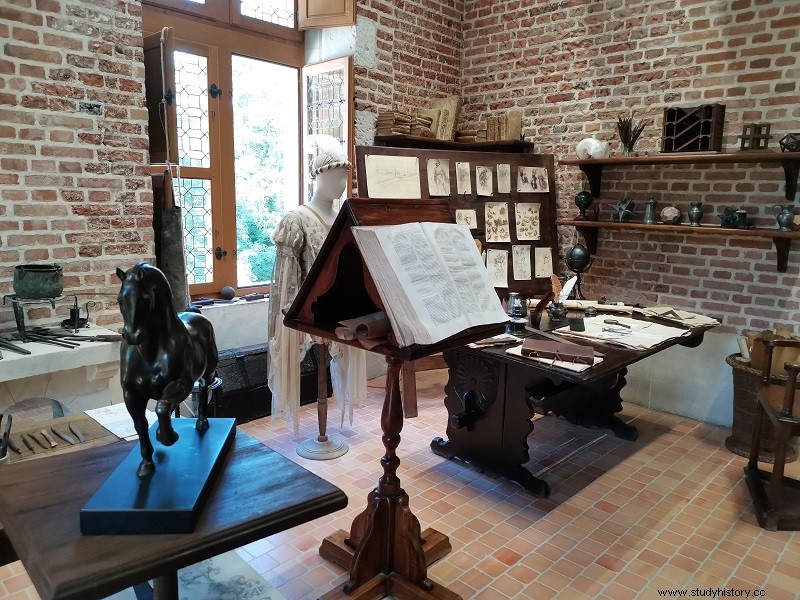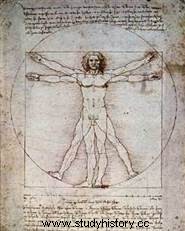 Leonardo da Vinci (1452-1519) was an Italian Renaissance artist and humanist, who was a painter, draftsman, sculptor, architect, but also a genius inventor. His most famous work is "La Joconde", a painting exhibited at the Louvre Museum. In addition to the paintings where this great artist wanted to reproduce nature as he felt it and "real" individuals in a harmonious atmosphere, he practiced in fields as diverse as anatomy, mechanics, science, botany, the flight of airplanes, war machines and paves the way for Copernicus and Galileo for gravitation, twinkling stars and the movement of the earth. At the end of his life, Leonardo da Vinci went to France where he was welcomed by King François I, who installed him at Clos-Lucé, very close to the Château d'Amboise.
Leonardo da Vinci (1452-1519) was an Italian Renaissance artist and humanist, who was a painter, draftsman, sculptor, architect, but also a genius inventor. His most famous work is "La Joconde", a painting exhibited at the Louvre Museum. In addition to the paintings where this great artist wanted to reproduce nature as he felt it and "real" individuals in a harmonious atmosphere, he practiced in fields as diverse as anatomy, mechanics, science, botany, the flight of airplanes, war machines and paves the way for Copernicus and Galileo for gravitation, twinkling stars and the movement of the earth. At the end of his life, Leonardo da Vinci went to France where he was welcomed by King François I, who installed him at Clos-Lucé, very close to the Château d'Amboise.
Youth of Leonardo da Vinci
Leonardo di ser Piero da Vinci better known as Leonardo da Vinci was born on April 15, 1452 in the small village that bears his name, 30 km from Florence. Son of a notary, his grandfather educated him summarily in the middle of the Tuscan countryside. At sixteen, he entered Florence, Verrocchio's studio who teaches him sculpture, painting, decoration and engraving. Among Sandro Botticelli, Peruguin and Domenico Ghirlandaio, he learns the basics of colors, performs small tasks and only a year later, he paints "drapes" on the characters.
 Verrocchio entrusted him with the execution of the face of one of the two angels on the painting The Baptism of Christ produced between 1470 and 1475. Remaining in Verrocchio's studio until 1476, he joined the Compagnie de Saint-Luc, a brotherhood of painters. Leonardo da Vinci's first painting was The Madonna with the Carnation , then The Adoration of the Magi painting full of movement where he creates the characters as if they were alive, as if they existed, with such realism that they are not extras.
Verrocchio entrusted him with the execution of the face of one of the two angels on the painting The Baptism of Christ produced between 1470 and 1475. Remaining in Verrocchio's studio until 1476, he joined the Compagnie de Saint-Luc, a brotherhood of painters. Leonardo da Vinci's first painting was The Madonna with the Carnation , then The Adoration of the Magi painting full of movement where he creates the characters as if they were alive, as if they existed, with such realism that they are not extras.
Meeting Ucello, he frequents his studio and talks together about geometry and perspective. For his paintings, he improves the technique of sfumato , a chiaroscuro technique, at a very high level of perfection. Contrary to the artists of his time, Leonardo refuses to show, with a clear line, the contours of the characters. On the contrary, he chooses to blur them, even to "smoke them out".
With Ludovic Sforza:the time of inventions
At thirty, da Vinci is called by Ludovic Sforza , Duke of Milan and remained in his service for twenty years. He wants to offer him the equestrian statue of the founder of the dynasty François Sforza...it was not made, so we don't really know what this rider looked like. With the duke, he performed several functions as decorator, sculptor, organizer of receptions, but also engineer, town planner, he worked in hydraulics with dams and locks and invented automatic devices.
 In mechanics, he is at the origin of the operation of machines in the textile field; on his sketches, he analyses, dismantles and reassembles clockwork systems, mills, pumps, transmission devices, planing and sawing machines…all this in drawings and sketches, of course. Ludovico Sforza was seduced by military engineering talents of the artist.
In mechanics, he is at the origin of the operation of machines in the textile field; on his sketches, he analyses, dismantles and reassembles clockwork systems, mills, pumps, transmission devices, planing and sawing machines…all this in drawings and sketches, of course. Ludovico Sforza was seduced by military engineering talents of the artist.
For the Duke of Milan, Leonardo worked, among other things, on the development of portable bridges, cannons, catapults and other war machines. Taken from one of Leonardo's notebooks, these diagrams represent various war machines allowing murderous offensives. The inventor thus imagined a cavalry weapon making it possible to mow down the enemy infantry ("the Scythian tank"), as well as a rotating cart with a metal shell, equipped with cannons and manipulated from the inside by eight men (true foreshadowing of the tank).
 He painted Ludovico Sforza's mistress The Lady with an Ermine , Lucrezia Crivelli can be La Belle Ferronnière du Louvre, then the Virgin of the Rocks from 1483 to 1486, in his Florentine style – which many denigrated and considered a bad copy! It begins The Last Supper intended for the wall of the refectory of the monastery of Saint Mary of the Graces in Milan, and uses an experimental mixture for the coating, but which will not be preserved for centuries to come, the fresco will be damaged. Besides paintings, da Vinci devoted himself to architectural drawings and plans.
He painted Ludovico Sforza's mistress The Lady with an Ermine , Lucrezia Crivelli can be La Belle Ferronnière du Louvre, then the Virgin of the Rocks from 1483 to 1486, in his Florentine style – which many denigrated and considered a bad copy! It begins The Last Supper intended for the wall of the refectory of the monastery of Saint Mary of the Graces in Milan, and uses an experimental mixture for the coating, but which will not be preserved for centuries to come, the fresco will be damaged. Besides paintings, da Vinci devoted himself to architectural drawings and plans.
Leonardo da Vinci in the service of Caesar Borgia
At the fall of the Sforzas in December 1499, da Vinci visited Venice, Mantua where he produced the profile portrait of the Duchess of Este and returned to Florence in 1503 in the service of Caesar Borgia , Duke of Romagna. He exercises his talents as an architect, acts as "site manager" of ecclesiastical fortresses, takes part in the commission deciding on the installation of Michelangelo's David. It was during this period that da Vinci will begin the battle of Anghiari for the Palazzo Vecchio but which will not be finished (only copies of the cartoons remain), then the portrait of Mona Lisa, the famous Mona Lisa between 1503 and 1506, who would become the star of the Louvre Museum.
Moreover, most of Vinci's great works have been destroyed, only the cartoons, drawings and sketches remain.
In 1506, da Vinci left for Milan and entered the service of Charles d'Amboise, Marshal of France, then entered the court of Louis XII as a painter and an ordinary engineer. Despite many trips to Florence to settle a lawsuit concerning the inheritance of a paternal uncle, he spent a few years in Rome under the protection of Pope Leo X (Giovanni de' Medici, son of Lorenzo the Magnificent) and devoted himself to scientific experiments. During this period, he painted the Saint John the Baptist, which he brought to France with most of his masterpieces, including La Joconde.
The Glory Years of Leonardo da Vinci
 During the French victory at the Battle of Marignan, da Vinci met King Francis I in Pavia. In 1516, the monarch brought him to France, to the Château du Clos-Lucé , near the castle of Amboise. He offers him a pension of seven hundred crowns and declares him "first painter, engineer and architect of the king", entrusting him with the project of the Château de Chambord. François I puts his residence at his disposal, as well as a princely pension of 1,000 gold crowns per year. Surrounded by the fervent affection of the young monarch and that of his sister Margaret of Navarre, Leonardo da Vinci was here free to dream, think and work.
During the French victory at the Battle of Marignan, da Vinci met King Francis I in Pavia. In 1516, the monarch brought him to France, to the Château du Clos-Lucé , near the castle of Amboise. He offers him a pension of seven hundred crowns and declares him "first painter, engineer and architect of the king", entrusting him with the project of the Château de Chambord. François I puts his residence at his disposal, as well as a princely pension of 1,000 gold crowns per year. Surrounded by the fervent affection of the young monarch and that of his sister Margaret of Navarre, Leonardo da Vinci was here free to dream, think and work.During his stay in Amboise, the Tuscan artist multiplied the projects and brings the final touches to his works. He thinks about town planning and hydraulic works, designs a project to reach Italy more easily, which consists of linking the Loire Valley to Lyonnais by a system of canals and locks. He plans to drain the unhealthy marshes of Sologne and imagines for the king a huge palace and plans for an ideal city to make Romorantin a new Rome. Leonardo da Vinci undoubtedly also inspired the architecture of the Château de Chambord with two fundamental concepts:that of the plan centered in a cross and that of the double spiral staircase. As a designer of royal celebrations with special effects, he notably staged a sumptuous “Feast of Paradise” at the Château du Cloux.
 “A busy day gives good sleep, a busy life gives a quiet death” says the Master who died at the age of 67 at Clos Lucé. He will have had time to bequeath his notes, notebooks and manuscripts to his pupil Francesco Melzi in charge of publishing them… Publication which will take place four hundred years later. These notebooks and manuscripts of Leonardo da Vinci, written from right to left, which must be deciphered in the mirror, reveal his “brilliant” side to us. Contrary to legend, it was not in the arms of the king that Leonardo died, François I being then in Saint-Germain-en-Laye. Escorted by a retinue of monks and beggars, his body was buried in the crypt of the Saint-Florentin collegiate church of the royal castle, devastated during the wars of religion. Excavations in 1863 revealed burial fragments with his presumed bones. They were transferred in 1874 to the castle chapel, where 500 years after his death, Leonardo da Vinci still rests.
“A busy day gives good sleep, a busy life gives a quiet death” says the Master who died at the age of 67 at Clos Lucé. He will have had time to bequeath his notes, notebooks and manuscripts to his pupil Francesco Melzi in charge of publishing them… Publication which will take place four hundred years later. These notebooks and manuscripts of Leonardo da Vinci, written from right to left, which must be deciphered in the mirror, reveal his “brilliant” side to us. Contrary to legend, it was not in the arms of the king that Leonardo died, François I being then in Saint-Germain-en-Laye. Escorted by a retinue of monks and beggars, his body was buried in the crypt of the Saint-Florentin collegiate church of the royal castle, devastated during the wars of religion. Excavations in 1863 revealed burial fragments with his presumed bones. They were transferred in 1874 to the castle chapel, where 500 years after his death, Leonardo da Vinci still rests. A Renaissance genius
Who better than Leonardo da Vinci embodies the Renaissance? Artist, scientist, architect, urban planner and engineer, researcher - in fields as varied as botany, hydrology or anatomy - he pushed to the extreme the versatility specific to the creators of this period. If he was then admired for his thought, his erudition and his moral qualities, it was his immense talent as a painter that the following generations praised before we rediscovered his writings and drawings at the end of the 19th century. Surprising machines, from the submarine to the helicopter via the automobile, then sprang from oblivion. Some of these "inventions" seem to hold as important a place in the history of techniques as the Mona Lisa in that of painting.
 However, Leonardo da Vinci is not outrageous in his singularity. His inventive spirit is a continuation of his predecessors and his "discoveries" are often linked to an existing tradition. In the military field, others, like Francesco di Giorgio, designed war machines before him.
However, Leonardo da Vinci is not outrageous in his singularity. His inventive spirit is a continuation of his predecessors and his "discoveries" are often linked to an existing tradition. In the military field, others, like Francesco di Giorgio, designed war machines before him.
In architecture, his plans do not surpass those of Bramante or Leon Battista Alberti, and his sketches of construction machinery are inspired by the research, again, of Francesco di Giorgio, himself marked by the work of Filippo Brunelleschi. Leonardo da Vinci's genius is elsewhere. He is more attached to his method, based primarily on observation.
Then comes the experience which, according to him, is “never faulted”. Unlike his contemporaries, he offers a practical approach that tends towards rationalization; his gears, he wants them solid and regular in order to be able to adapt them to different types of use - looms, hydraulic turbines or theater machinery. His talent also lies in the quality of his sketches. His mastery of perspective, shadows and lights gives the impression of existing objects, ready to function. Drawing becomes an instrument to capture the essence of things. And no one can doubt while admiring his flying machines that man will one day take himself for a bird...
Bibliography
- Leonardo da Vinci by Sophie Chauveau, biography. Folio, 2008.
- Leonardo da Vinci, biography of Jean-Yves Boriaud. Perrin, 2002.
- Leonardo da Vinci:Art and Science of the Universe, by Alessandro Vezzosi. Gallimard, 2010.
- The Machines of Leonardo da Vinci, by Domenico laurenza. Gründe, 2006.
